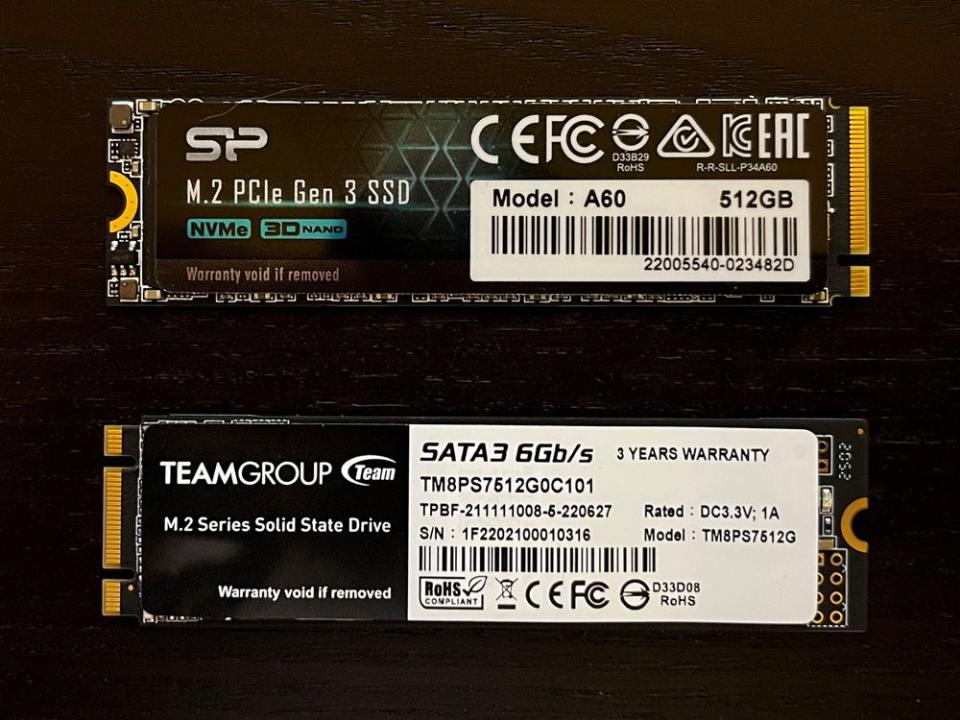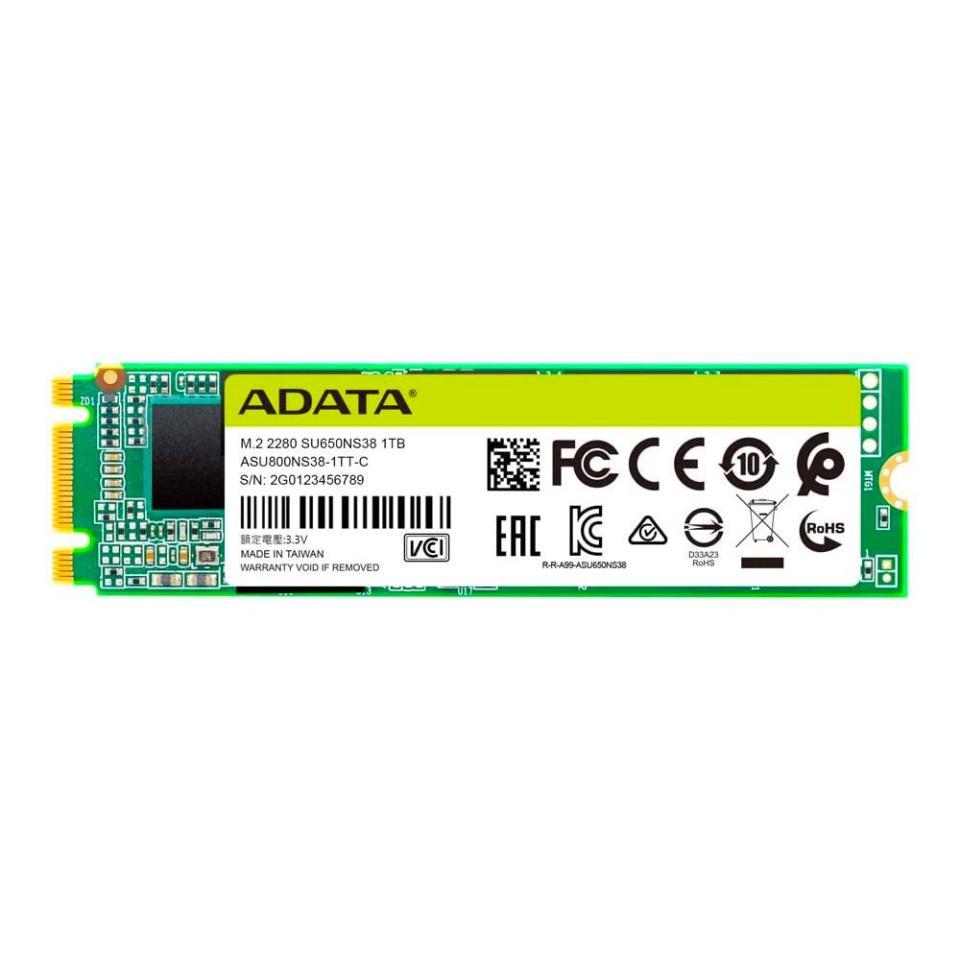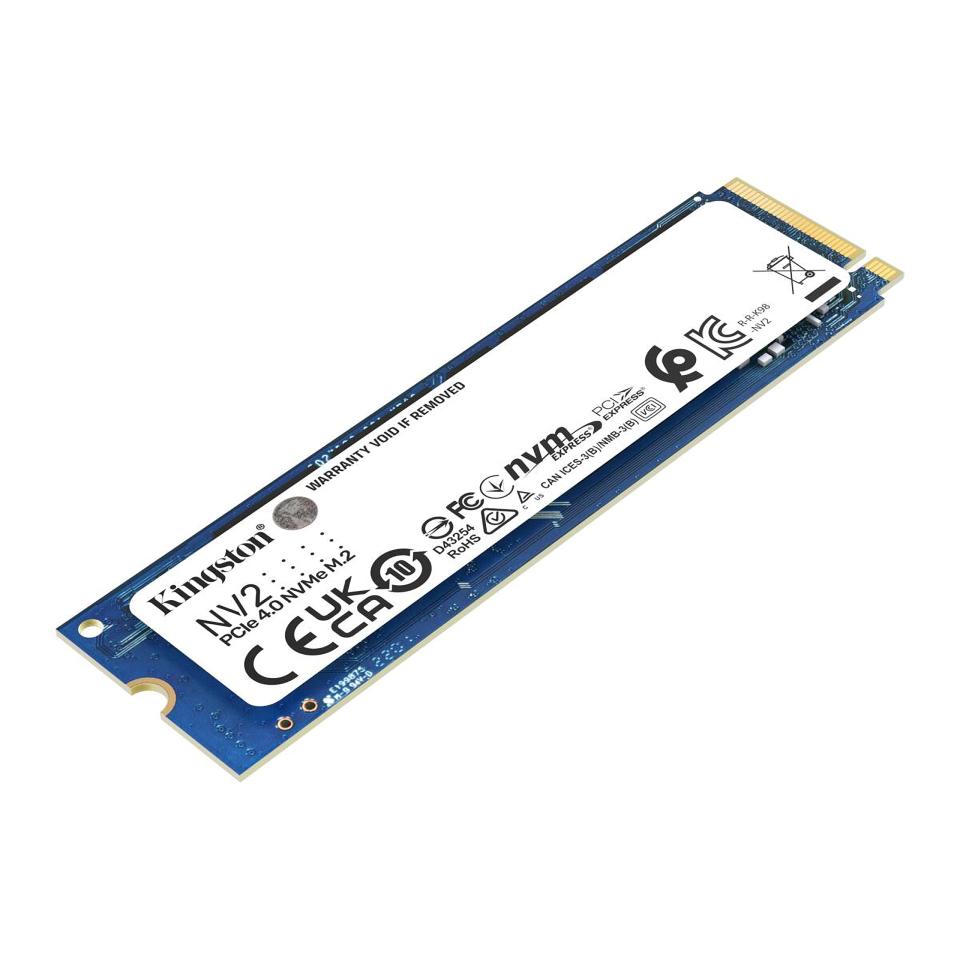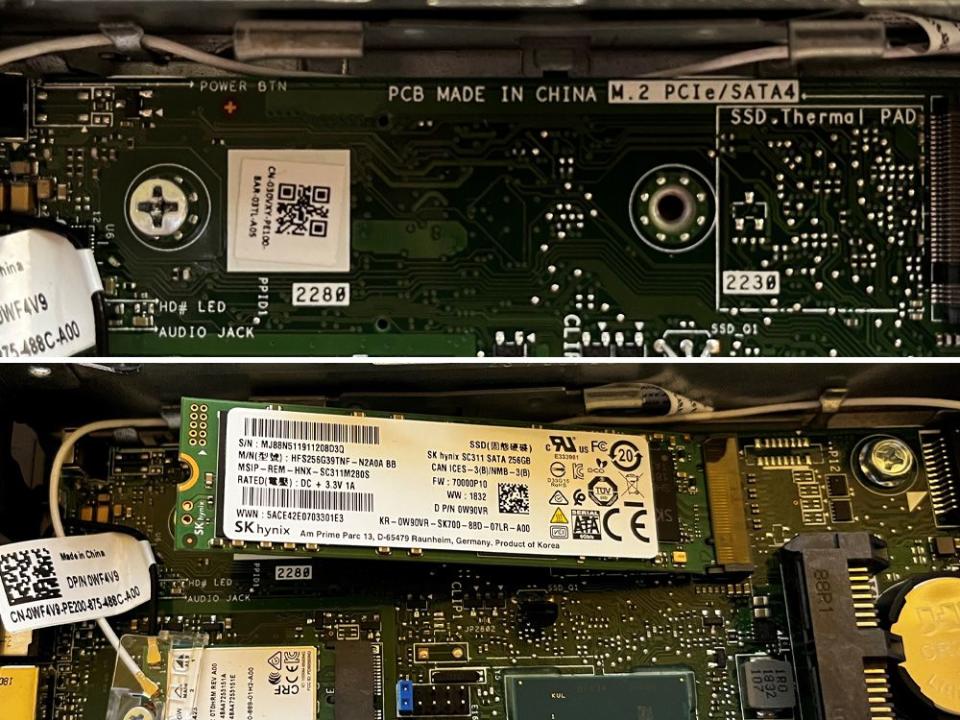Level Up Your Computer's Storage With These M.2 SSDs

"Hearst Magazines and Yahoo may earn commission or revenue on some items through these links."
It wasn’t always so simple to add storage to a desktop or laptop. For decades, PC storage was synonymous with bulky, mechanical hard drives. The first hard drive was sold in 1956, but it wasn’t until the 1980s that hard drives actually became available to consumers—and it was the 1990s before they went mainstream.
SSDs (Solid State Drives), semiconductor-based storage devices, have been in existence in one form or another since the late 1970s. It was only in the last decade or so that you could buy one. SSD drives greatly improve performance and reliability by storing data on chips instead of spinning magnetic platters. Since SSDs have no moving parts compared mechanical hard drives which do, there’s less chance for something to go wrong.
A conventional SSD (which looks a lot like a mechanical hard drive) is primarily designed as a drop-in replacement for its hard drive predecessors. It’s not only bigger than it needs to be, but is also hamstrung by an aging interface called SATA (Serial Advanced Technology Attachment) which prevents an SSD’s speedy storage chips from reaching their full performance potential.
The M.2 (pronounced m dot two) form factor, introduced in 2012, was designed to replace the mSATA interface, a version of the SATA interface for solid state drives (SSDs) in mobile devices.
Although most desktops or laptops built within the past five to seven years should accommodate an M.2 SSD, there are exceptions. Second, not all M.2 SSDs are the same since “M.2” is an umbrella term for modules that come in certain standardized shapes and sizes. M.2 SSDs may use one of a few different interfaces, and which one of these interfaces your PC supports determines the level of performance you can expect—or whether it will work in your PC at all.
A prerequisite to any M.2 SSD purchase then is to first consult your desktop or laptop’s motherboard specs to verify not only the presence of an M.2 socket, but also to determine its capabilities. PC manufacturers don’t always put this information in the owner’s manual, however, so an online search (be sure you use the exact model of your PC in queries) should turn up the information you need. For example, the spec sheet for my circa-2020 Dell XPS 8940 desktop supports the “M.2 2280/2230 M-key (PCIe 3.0 x4, NVMe)”.
At this point, M.2s are a smart option for pretty much everybody, no matter what you use your PC for—office work, gaming, content creation, whatever. You should only consider an old-fashioned hard drive if you need gargantuan amounts storage (hard drives still have SSDs beat in terms of raw capacity).
More To Consider: Laptop Bags • Laptop Docking Stations • Dell Laptops • Fast Chargers for iPhones, Tablets and Laptops
Best M.2 SSDs
The Expert: For nearly 30 years I’ve been an IT professional, personal tech consultant, freelance technology writer, and book author who spends probably a bit more time than I should hip-deep in the latest tech. Over the past couple of years, I’ve personally given several dozen PCs a new lease on life by performing SSD upgrades.
How to Choose an M.2 SSD
Physical Size
Most desktop and laptops support M.2 “2280” modules, a label that refers to the device’s width and length (22-mm and 80-mm, respectively). While M.2 2280 modules represent the lion’s share of the market, other lengths do exist, including 30-, 42-, and 60-mm. (A 30-mm M.2 is labeled “2230” and so on). Although it’s not especially common, some laptops—ones that are older or with very small footprints—may only accommodate shorter-length modules. Some, as indicated by the specifications of my PC mentioned above, may support multiple lengths.
Interface and Connector Type
Modern M.2 SSDs connect to the PC via one of two versions of the PCIe (Peripheral Component Interconnect Express) interface, either Gen 3 or Gen 4 (also called 3.0 and 4.0) and use a communication protocol called NVMe (Non-Volatile Memory Express). Compared to SATA, which offers a maximum of about 600 MB/s (Megabytes per second) of throughput, PCIe 3 can provide up to 3.9 GB/s (Gigabytes per second, more than a sixfold increase) while PCIe 4 doubles that to 7.8 GB/s.
If your PC supports a PCIe/NVMe-based M.2 SSD, that’s the way to go. Most PCs manufactured within the past five years or so should support PCIe 3, while support for PCIe 4 is more recent and thus less common. The two PCIe standards are backward-compatible, so if you install a PCIe 4 M.2 SSD in a system that supports PCIe 3, or vice-versa, it will still work, albeit at a lower level of performance. (Note: Performance is also determined by the type of storage chips, known as NAND Flash Memory, and other components an M.2 SSD uses, so two devices equipped with the same interface may have somewhat different performance.)
If your PC lacks support for PCIe/NVMe-based M.2 SSDs, opt for one that uses SATA. Although a SATA-based M.2 SSD’s performance won’t generally be any better than an SSD that uses the conventional hard drive form-factor (since they both communicate via the same SATA interface), it’s still many times faster than a mechanical hard drive.
Also check the connector type an M.2 SSD uses. M.2 SSDs with a PCIe/NVMe interface have a connector with one notch known as an “M-key”. The connector on a SATA-based M.2 SSD has two notches and is known as a “B+M key”. On the PC side, the M.2 socket will almost always be an M-key connector. An M-key M.2 SSD will work just fine in an M-key M.2 socket, while a B+M key M.2 SSD will physically fit in an M-key socket but may or may not work, depending on which interface(s) your system supports.
Capacity
As a rule, buy the largest-capacity M.2 SSD your budget allows. Storage is frequently something you think you have enough of until suddenly, you don’t. Unless your storage needs are truly minimal (e.g., you keep your data solely in the cloud and don’t need local copies of most of your files), don’t consider anything smaller than 500 GB. Give yourself room to grow. Installing an M.2 SSD takes enough effort—especially on some laptops-- that you probably won’t want to do it more than once if you can help it.
Performance Rating
Read and write times are another metric to help you choose an SSD. The faster, the better, meaning faster boot times, quicker application launches, and better overall system performance. Sequential read/write means reading/writing contiguous areas of storage, whereas random refers to reading/writing random areas of storage. The former is a good metric of performance when you're predominantly dealing with large files—creating/playing videos, for example, as those files can be exceedingly large. The latter is a better indicator of overall performance, so more relevant for the general usage.
That said, there isn't really a target performance number to recommend, other than "higher is better," because the performance you actually get depends on whether your PC supports the same standard the M.2 SSD does and the specific applications you use. Note the performance numbers here are what the manufacturer claims, not necessarily what may be ultimately achieved.
How We Evaluated These M.2 SSDs
I selected these M.2 SSDs based on several criteria including features, price, value, capacity, and rated performance figures. All the recommendations here are M.2 2280 modules (the most widely supported), and most are in the price/capacity sweet spot between 500 GB and 2 TB. You will generally pay a lot more per GB of storage when you go over 2 TB.

SAMSUNG 980 PRO 2TB PCIe MZ-V8P2T0B
Samsung makes all its own SSD components, and it shows, given that the SAMSUNG 980 PRO's performance ratings are about as good as it gets (up to 7000 MB/s read, 5100 MB/s write).
Also included is software to monitor drive health as well as encrypt and update the device. This type of software tends to be vendor-specific; some companies offer it and some don't.

SAMSUNG 980 PRO 2TB PCIe MZ-V8P2T0B
$139.00
amazon.com
FireCuda 530 4TB
It’s by no means cheap, but if you want both high performance and high capacity (and your system supports PCIe 4), the Seagate FireCuda 530 4TB Solid State Drive is an excellent choice.
It’s rated performance of up to 7250 MB/s read and 6900 MB/sec write is comparable to the just-mentioned Samsung 980 Pro, but you can’t get the Samsung one in a 4 TB capacity.
The FireCuda includes three years of Seagate’s Rescue Data Recovery Services, which claims 95-percent success against unexpected data loss.

FireCuda 530 4TB
$449.95
amazon.com
CS2130 4TB M.2 NVMe M280CS2130-4TB-RB
If you need lots of capacity but have limited funds, the PNY CS2130 4TB M.2 NVMe Internal Solid State Drive (SSD) M280CS2130-4TB-RB gives you 4 TB and rings up for significantly less than most other M.2 SSDs of the same capacity. It also offers U.S.-based 24/7 technical support.

CS2130 4TB M.2 NVMe M280CS2130-4TB-RB
$486.04
amazon.com
AData ADATA SU650 1TB M.2 (ASU650NS38-1TT-C)
Does your system have an M.2 socket that’s not compatible with the latest PCIe/NVMe standards? The AData ADATA SU650 1TB M.2 (ASU650NS38-1TT-C) will work in your system, though it will admittedly will not perform anywhere near the level of a PCIe/NVMe M.2 SSD (550 MB/s reads, 510 MB/s writes).
The low performance is a limitation of the SATA interface, not of the product itself. As a bonus, it includes migration software for copying the contents of a previous hard drive or SSD.

AData ADATA SU650 1TB M.2 (ASU650NS38-1TT-C)
$134.44
amazon.com
NV2 500G M.2 2280 NVMe SNV2S/500G
Kingston has been in the storage business for a long time, so it’s no surprise it offers decent bang for the buck. If you’re on a tight budget, the NV2 manages to be a bit less expensive per GB than the NV1. The new version gives you 500 GB of storage for under 6 cents per GB. Note: This drive is best suited to systems with limited space, like thinner laptops and smaller form factor PCs.
While it won’t likely win any performance battles against higher-end hardware, this Kingston NV2 improves on its predecessor, the NV1, (our recommendation for 2022), by supporting PCIe Gen 4 whereas the NV1 only supported PCIe Gen 3.
Additionally, the NV2 delivers up to 3500 MB/sec sequential reads and 2100 MB/sec sequential writes whereas the NV1 only offered up to 2100 MB/sec for sequential reads and 1600 MB/s for sequential writes.

NV2 500G M.2 2280 NVMe SNV2S/500G
$29.80
amazon.com
Viper VPR400 1TB Internal RGB SSD W/HS (VPR400-1TBM28H)
If you like to show off the innards of your desktop PC, you’ll probably appreciate this Patriot Viper VPR400, with an integrated aluminum heatsink that includes customizable RGB lighting. The drive comes with software to control the lighting effects or can work with the RBG lighting software of major motherboard vendors including Asus and Gigabyte.
The main catch—it’s anywhere from 50- to 80-percent pricier than a comparable PCIe 4 SSD without lighting.

Viper VPR400 1TB Internal RGB SSD W/HS (VPR400-1TBM28H)
$74.99
amazon.com
Ready to Boost Your PC? Our Expert Joseph Moran Gives You Guidance on Buying an M.2 SSD.
PM: My desktop PC doesn’t have an M.2 socket. Am I out of luck?
JM: Not necessarily. If your PC has a free PCIe slot (and chances are it does) you can use an M.2 PCIe expansion card (generally between $15 and $50) to add up to four M.2 SSDs to your PC.
PM: How much effort does it take to access the M.2 socket inside a laptop?
JM: That depends on the laptop. At the very least, you’ll likely need to remove the entire bottom cover (usually 10 screws, often of varying length, so note which one goes where), but some laptops may require further disassembly to access the M.2 socket. Definitely consult the service manual or check out a YouTube video in advance to see how involved the process will be.
PM: Is there any reason to choose a hard drive over an M.2 SSD these days?
JM: Yes, if you absolutely need the most storage at the lowest possible cost. For example, an internal 8 TB hard drive can be had for as little as $150. In contrast, an 8 TB M.2 SSD will set you back between $1,200 and $1,500. Need even more storage? A 16 TB hard drive currently carries a price tag of around $350, but an M.2 SSD of equivalent capacity…is not even a thing. (At least, not for consumers—yet.)
PM: Do I need to buy an SSD that comes with a warranty?
JM: Yes. Luckily most M.2 SSDs (and all the ones featured here) come with a three- or five-year warranty. Remember that the warranty doesn’t protect your data though—so always back it up.

You Might Also Like

